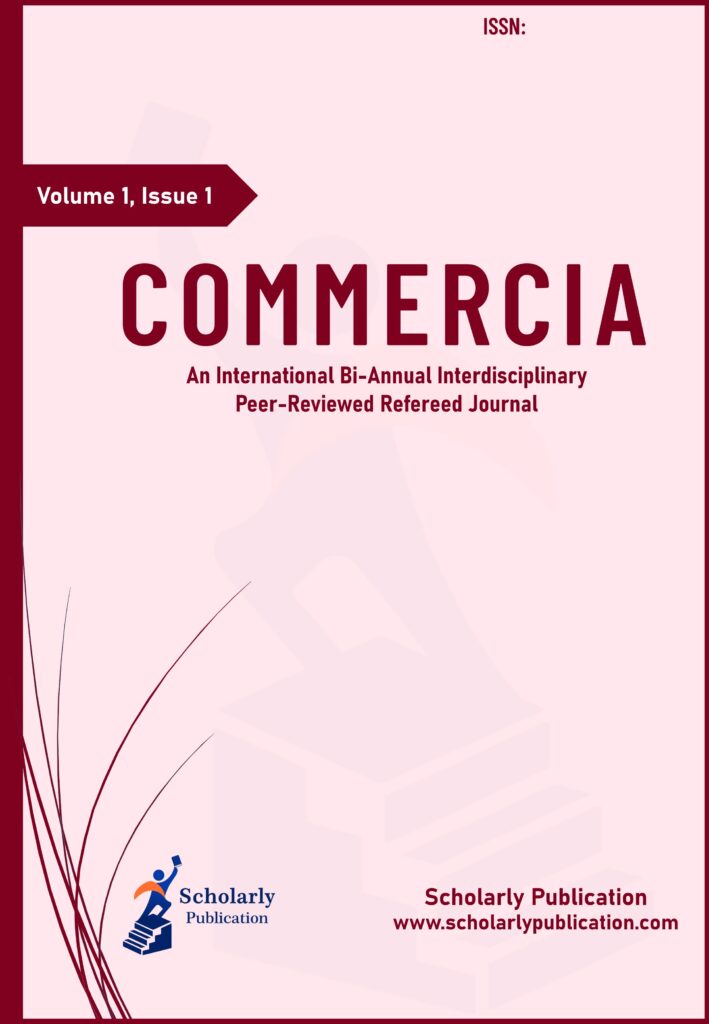Reducing Bias and Strengthening Objectivity in Performance Appraisal: A Thematic Analysis
Volume 1, Issue 1, Article Number: 251008 (2025)
Home >> Commercia >> Volume 1, Issue 1
Mohammad Shakeel Akhtar1,* | Dr. Vimlesh Tanwar2 | Dr. Nishtha Pareek3
1Research Scholar, Department of Commerce and Management, Banasthali Vidyapith, Tonk 304022, Rajasthan, India
2Assistant Professor, Department of Commerce and Management, Banasthali Vidyapith, Tonk 304022, Rajasthan, India
3Associate Professor, Department of Commerce and Management, Banasthali Vidyapith, Tonk 304022, Rajasthan, India
*Corresponding Author: md.shakeel.akhtar@gmail.com
Received: 12 May 2025 | Revised: 18 May 2025
Accepted: 19 May 2025 | Published Online: 21 May 2025
DOI: https://doi.org/10.5281/zenodo.15472775
© 2025 The Authors, under a Creative Commons license, Published by Scholarly Publication
Abstract
Appraisals are fundamental to the management of human resources since they affect the development of an employee, the organizational fairness, and the advancement in one’s career. However, performance appraisal systems tend to lack precision due to biases that adversely impact trust, fairness, accuracy, and objectivity. This thesis aims to analyze reasons for biases in performance appraisal and determine practical methods to improve objectivity using action-oriented thematic analysis. Following qualitative literature synthesis, three overarching themes were identified: biases associated with raters, alterations proposed to enhance structures and processes, and use of technology. Findings highlight biases such as halo bias, age, ethnicity and gender biases, and leniency bias are steeped in cultural and organizational deep cognitive frameworks. An increase in measurement precision is essential in overcoming biases using Z-ethically acceptable design, CPM systems, automated feedback BARS, AI, and analytics. It is emphasized that technological frameworks must be approached from the standpoint of fairness, devoid of historical inequity perpetuation. Ultimately, the argument presented in the text underscores the complexity of the intervention using systems approach combining governance by ethical machine systems with human retraining, organizational strategy redesign, and allegiance to bounding policies for structural fairness, openness, inclusion, and objectivity.
Keywords
Performance Appraisal, Bias Mitigation, Objectivity, Rater Training, Behaviorally Anchored Rating Scales (BARS), 360-Degree Feedback, Continuous Performance Management (CPM), Organizational Fairness, Systemic Discrimination
References
Aguinis, H. (2013). Performance management (3rd ed.). Pearson Education.
Aguinis, H., Joo, H., & Gottfredson, R. K. (2011). Why we hate performance management—and why we should love it. Business Horizons, 54, 503–507.
[View Article] [Google Scholar]
Bernardin, H. J., & Beatty, R. W. (1984). Performance appraisal: Assessing human behavior at work. Kent Publishing.
Bracken, D. W., Timmreck, C. W., & Church, A. H. (2001). The handbook of multisource feedback. John Wiley & Sons.
Braun, V., & Clarke, V. (2006). Using thematic analysis in psychology. Qualitative Research in Psychology, 3, 77–101.
[View Article] [Google Scholar]
Bretz, R. D., Milkovich, G. T., & Read, W. (1992). The current state of performance appraisal research and practice: Concerns, directions, and implications. Journal of Management, 18, 321–352.
[View Article] [Google Scholar]
Cappelli, P., & Tavis, A. (2016). The performance management revolution. Harvard Business Review, 94, 1500–1509.
Cardy, R. L., & Dobbins, G. H. (1994). Performance appraisal: Alternative perspectives. South-Western College Pub.
DeNisi, A. S., & Murphy, K. R. (2017). Performance appraisal and performance management: 100 years of progress? Journal of Applied Psychology, 102, 421–433.
[View Article] [Google Scholar]
DeNisi, A. S., & Williams, K. J. (1988). Cognitive approaches to performance appraisal. In G. R. Ferris & K. M. Rowland (Eds.), Research in personnel and human resources management, 6, 109–155. JAI Press.
Goler, L., Gale, J., Harrington, B., & Grant, A. (2016). Why people really quit their jobs. Harvard Business Review, 94, 48–57.
Greenhaus, J. H., Parasuraman, S., & Wormley, W. M. (1990). Effects of race on organizational experiences, job performance evaluations, and career outcomes. Academy of Management Journal, 33, 64–86.
[View Article] [Google Scholar]
Heilman, M. E., & Caleo, S. (2018). Combatting gender discrimination: A lack of fit framework. Group Processes & Intergroup Relations, 21, 725–744.
[View Article] [Google Scholar]
Joshi, A., Son, J., & Roh, H. (2015). When can women close the gap? A meta-analytic test of sex differences in performance and rewards. Academy of Management Journal, 58, 1516–1545.
[View Article] [Google Scholar]
Kellogg, K. C., Valentine, M. A., & Christin, A. (2020). Algorithms at work: The new contested terrain of control. Academy of Management Annals, 14, 366–410.
[View Article] [Google Scholar]
King, E. B., Hebl, M. R., & Beal, D. J. (2009). The personal is political: A review of research on individual differences and intergroup processes in organizations. Academy of Management Annals, 3, 461–496.
Levenson, A. (2018). Using workforce analytics to improve strategy execution. Human Resource Management, 57, 685–700.
[View Article] [Google Scholar]
London, M., & Smither, J. W. (2002). Feedback orientation, feedback culture, and the longitudinal performance management process. Human Resource Management Review, 12, 81–100.
[View Article] [Google Scholar]
Nowack, K. M., & Mashihi, S. (2012). Evidence-based answers to 15 questions about leveraging 360-degree feedback. Consulting Psychology Journal: Practice and Research, 64, 157–182.
[View Article] [Google Scholar]
O’Neil, C. (2016). Weapons of math destruction: How big data increases inequality and threatens democracy. Crown Publishing.
Pulakos, E. D. (2009). Performance management: A new approach for driving business results. Wiley-Blackwell.
Pulakos, E. D., Hanson, R. M., Arad, S., & Moye, N. (2015). Performance management can be fixed: An on-the-job experiential learning approach for complex behavior change. Industrial and Organizational Psychology, 8, 51–76.
[View Article] [Google Scholar]
Smith, P. C., & Kendall, L. M. (1963). Retranslation of expectations: An approach to the construction of unambiguous anchors for rating scales. Journal of Applied Psychology, 47, 149–155.
[View Article] [Google Scholar]
Sulsky, L. M., & Day, D. V. (1992). Frame-of-reference training and cognitive categorization: An empirical investigation of rater memory. Journal of Applied Psychology, 77, 501–510.
Cite This Article
M. S. Akhtar, V. Tanwar, and N. Pareek, “Reducing Bias and Strengthening Objectivity in Performance Appraisal: A Thematic Analysis,” Commercia 1(1) (2025) 251008. https://doi.org/10.5281/zenodo.15472775
Rights & Permission
This is an open access article published under the Creative Commons Attribution (CC BY) International License, which allows unrestricted use, distribution, and reproduction in any medium, provided the original work is properly cited. No permission is needed to reuse this content under the terms of the license.
For uses not covered above, please contact the Scholarly Publication Rights Department.

